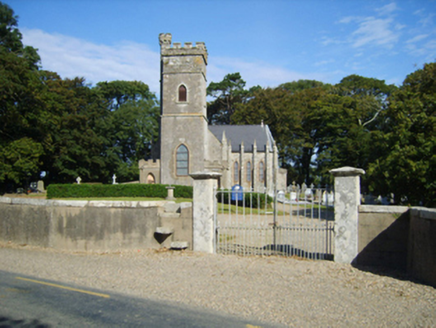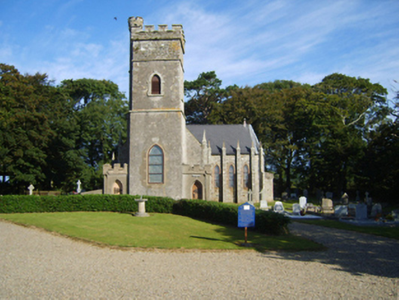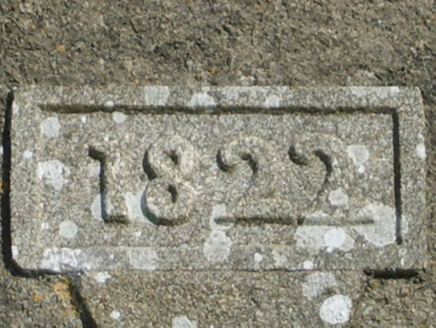Survey Data
Reg No
15704608
Rating
Regional
Categories of Special Interest
Architectural, Artistic, Historical, Social, Technical
Original Use
Church/chapel
In Use As
Church/chapel
Date
1815 - 1825
Coordinates
287178, 110998
Date Recorded
18/09/2007
Date Updated
--/--/--
Description
Detached six-bay double-height Board of First Fruits Church of Ireland church, built 1820-2; dated 1822, on an L-shaped plan originally five-bay double-height single-cell on a rectangular plan comprising five-bay double-height nave opening into single-bay double-height apse (north) on a half-octagonal plan with pair of single-bay single-storey vestries centred on single-bay three-stage tower to entrance (south) front on a square plan. "Improved", 1874, producing present composition. "Restored", 1893. Pitched slate roof; half-octagonal slate roof (north), trefoil-crested lichen-covered roll moulded clay ridge tiles, and cast-iron rainwater goods on rendered eaves retaining cast-iron octagonal or ogee hoppers and downpipes. Roughcast coursed rubble stone walls with obelisk pinnacle-topped cut-granite stepped buttresses to corners; roughcast surface finish (tower) with battlemented parapet (top stage) having cut-granite coping. Pointed-arch window openings between obelisk pinnacle-topped cut-granite stepped buttresses with "bas-relief" surrounds framing storm glazing over fixed-pane fittings having leaded stained glass margins centred on lattice glazing bars. Pointed-arch window openings (apse) with "bas-relief" block-and-start surrounds framing storm glazing over fixed-pane fittings having leaded stained glass panels. Pointed-arch window opening (tower) below lichen-spotted cut-granite date stone ("1822") with "bas-relief" block-and-start surround framing storm glazing over fixed-pane fitting having leaded stained glass margins centred on lattice glazing bars. Pointed-arch openings (bell stage) with lichen-spotted cut-granite sills, and lichen-spotted cut-granite block-and-start surrounds centred on keystones framing louvered timber fittings. Pointed-arch door openings (vestries) with "bas-relief" block-and-start surrounds framing timber boarded or tongue-and-groove timber panelled doors. Interior including vestibule (south) with polished brass plate (1910); full-height interior open into roof with carpeted central aisle between timber pews, wall monuments (ob. 1824; 1932), exposed pointed-arch braced collared timber roof construction on cut-granite "Cavetto" corbels with wind braced timber boarded ceiling, Gothic-style timber panelled pulpit on an octagonal plan with Gothic-style timber clerk's desk, and pointed-arch chancel arch framing cut-granite stepped dais to chancel (north) with wrought iron-detailed balusters supporting polished brass communion railing centred on Gothic-style timber altar below stained glass "North Window" (1840). Set in landscaped grounds with lichen-covered cut-granite monolithic piers to perimeter having shallow pyramidal capping supporting arrow head-detailed wrought iron double gates.
Appraisal
A church erected with financial support from the Board of First Fruits (fl. 1711-1833) representing an integral component of the nineteenth-century ecclesiastical heritage of south County Wexford with the architectural value of the composition, 'a neat edifice with a square tower' (Lewis 1837 II, 60), suggested by such attributes as the standardised nave-with-entrance tower plan form, aligned along a liturgically-incorrect axis; the slender profile of the openings underpinning a "medieval" Gothic theme; and the turreted battlements embellishing the tower as a picturesque eye-catcher in the landscape: meanwhile, aspects of the composition clearly illustrate the later "improvement" of the church (1874) 'to the Honour of Almighty God and in loving memory of…Henry Holdsworth Hunt [1774-1829]'. Having been reasonably well maintained, the elementary form and massing survive intact together with substantial quantities of the historic or original fabric, both to the exterior and to the interior where contemporary joinery; restrained wall monuments commemorating the prolific Letts (cf. 15701528; 15702035; 15702617; 15704607); and an abbreviated "North Window" attributed to M. and R. Sillery of Middle Abbey Street, Dublin (DIA), all highlight the artistic potential of the composition: meanwhile, an exposed timber roof construction pinpoints the engineering or technical dexterity of a church making a pleasing visual statement in a sylvan street scene.





